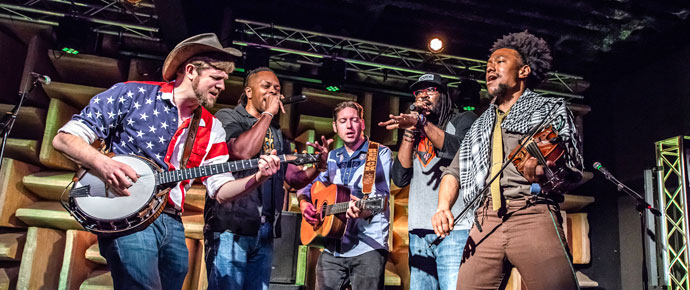
Bluegrass and hip hop are rarely spoken of in the same context. And the fusion of the two forms puts the band Gangstagrass beyond those borders in the strictest sense. Indeed, this intrepid ensemble has managed to make a bold statement by plying banjos and fiddles with rap and beats.
Rench, the founder and original mastermind behind this otherwise unlikely idea, began his career as a rapper, emcee, producer and singer/songwriter well before coming up with the idea of combining a traditional bluegrass sound with elements spawned from an urban influence. Granted, it’s not what most people on either side of this musical divide might be accustomed to. It’s likely that even fewer might think it could work. And yet, the combination has worked surprisingly well. Gangstagrass found immediate acceptance when they scored the theme song for the FX series, Justified, while garnering themselves an Emmy nomination for their efforts. A series of studio albums and their recent live effort, Pocket Full of Fire, reaped similar success, with the new release climbing to the heights of the bluegrass charts. Their audiences adore them, making it little wonder that they’ve become festival favories in the process.
The band currently consists of Rench (vocals, guitars, beats) Dan Whitener (banjo, vocals), R-Son The Voice of Reason (vocals), Dolio The Sleuth (vocals), and Brian Farrow (fiddle), and the sound they create offers due credence to both of the disciplines they draw from.
We recently had the opportunity to rap with Rench and ask him to offer his insights into why and how their music works as well as it does.
For starters, can you give us an idea of your early influences?
My dad exposed me to a lot of honky tonk as a kid…lots of Hank, Willie, and George Jones, and also Gram Parsons and the Flying Burrito Brothers… so I got to branch out there into a broader mix. But when I was in third grade, all I wanted to listen to was hip-hop. Beat Street and the Breakin’ movies came out, and my friends would spend recess breakdancing. The first record I got on my own was a 45 of Rockit by Herbie Hancock. It was the hot breakdancing track at the time. The next couple years was a lot about RUN-DMC and the Beastie Boys.
When you first came up with the idea for Gangstagrass, did you have any concerns about the pushback with such a bold crossover?
I had no trepidation. I wasn’t even thinking about it being a bold crossover. It was just the sound that I wanted to hear, and my only thought was just having fun with it. I was learning more about Gram Parsons and how he was crossing genres, and I was just feeling like that’s what it’s all about. I wanted something with breakbeats and steel guitars and record scratching and fiddles. There wasn’t much out there to provide it, so the only thing was to start experimenting.
Do you feel like your music might be helping to narrow the cultural divide in any way?
It feels like the country is becoming a Hatfields and McCoys reunion or something. I definitely feel like this image we’ve gotten of a rural vs. urban divide has been used to keep us disconnected. There are so many stories showing us the worst of each other, rather than how much we may struggle with the same things. We get scared of each other, and that is very dangerous. I hope something really changes on that, but in our little corner of music, we want take any opportunity we can to represent how things you might think are so different can actually be awesome together, and how we can find common ground we didn’t know we had.
In the case of the music industry, the public was given the impression of separate southern music for white and black audiences with the first recorded music in the 1920s. That was so they could sell music to segregated audiences, and that worked its way deep into our music and our culture. We want to draw that back and show how that was a lie, that southern music was blending and bleeding across racial and cultural lines. The banjo was an African instrument, and there were prevalent black and multi-racial early string bands that developed the foundation of music that was artificially separated into “race records” and “hillbilly records,” and eventually into blues versus country music.
So we see ourselves as a bit of a family reunion. We’re saying that American music has mixed roots and a mixed future.
So what kind of reaction have you gotten from both the bluegrass and rap camps?
We get a ton of love from both bluegrass and rap audiences. What we find is that so many music fans already have eclectic tastes. They don’t actually confine their playlists to one genre or another. They are simply looking for the good stuff. So when we show up, it’s not even about people looking at us from the perspective of being a hip-hop head or a country music fan. They’re often both… and a whole bunch more.
So where to from here?
We are currently in our 12th week near the top of the bluegrass charts with our live album release Pocket Full Of Fire, and there are more videos and bonus content coming from that. New material is getting written and road-tested to take us into the next phase of evolving our sound. The next studio album is going to be totally crazy.







